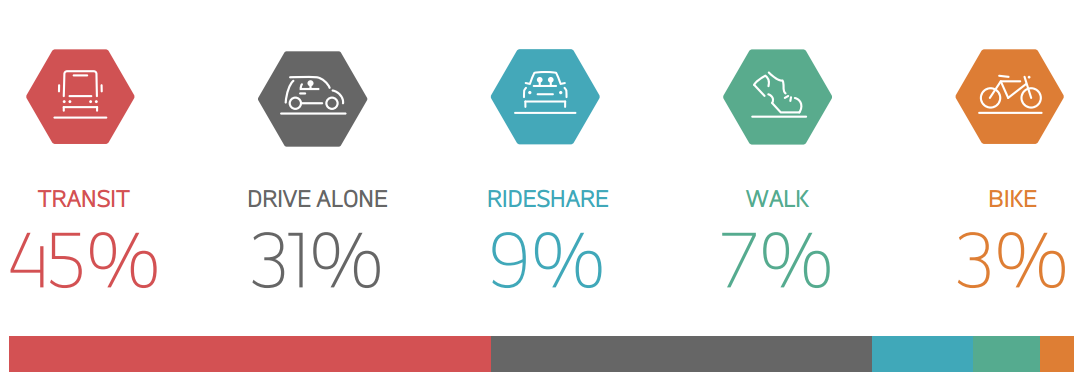
Commute Seattle released new survey data,with the help of EMC Research, that shows a growing percentage of Downtown commuters rely on modes other than single occupancy vehicles (SOVs). In fact, 60% of commuters don’t drive at all, instead opting for transit, walking, or cycling.
The mode split by type has changed significantly since the last survey, which was completed in 2012. Nearly 4% fewer people drove alone compared to that survey and it seems likely that Seattle will reach its goal of 30% or less by 2016. The largest companies (100+ employees) in Downtown still had the lowest drive alone rate, but medium sized companies (20-99 employees) saw the most progress, reducing rates from 37% to 30% since the last survey. King County Executive Dow Constantine summed up this progress well:
More commuters than ever are taking advantage of the reliable transit service we provide to Downtown Seattle. Our region’s prosperity relies on people’s ability to get to and from work each day, so it’s critical that we build the transportation systems needed to keep up with our growing population.
Perhaps the most impressive statistic is that non-motorized modes have seen the largest increase. This is also great news for the city because it means people are living closer to work, which is likely only possible due to the immense amount of development that is occurring in Seattle’s downtown core.

Commute Seattle also provided the mode split going all the way back to their 2010 survey. Declining numbers for rideshare and SOVs are apparent. Perhaps the most interesting piece of data is that the total number of commuters driving decreased between 2012 and 2014 even though the number of commuters grew by 8,000 people at least 8,000 (the job numbers are from 2013 and we’re still waiting on 2014 numbers). This is different than The 2012 research which showed a decline in the rate of driving alone but an increase in the total numbers. With that said, even though the rates decreased the total number of commuters driving alone is the same as 2010 due to the increase in population. This explains why anyone who drives alone on their commute hasn’t seen any improvement in traffic. It also fits with the counter-intuitive research that has shown adding more road capacity doesn’t improve traffic, since reducing the percentage of drivers is similar to adding road capacity.

Update: The totals under 2014 for jobs are actually from 2013 and Commute Seattle will be updating them when they get the 2014 numbers. It’s likely this will mean the total number of people driving alone will increase from 2012.

Owen Pickford
Owen is a solutions engineer for a software company. He has an amateur interest in urban policy, focusing on housing. His primary mode is a bicycle but isn't ashamed of riding down the hill and taking the bus back up. Feel free to tweet at him: @pickovven.

